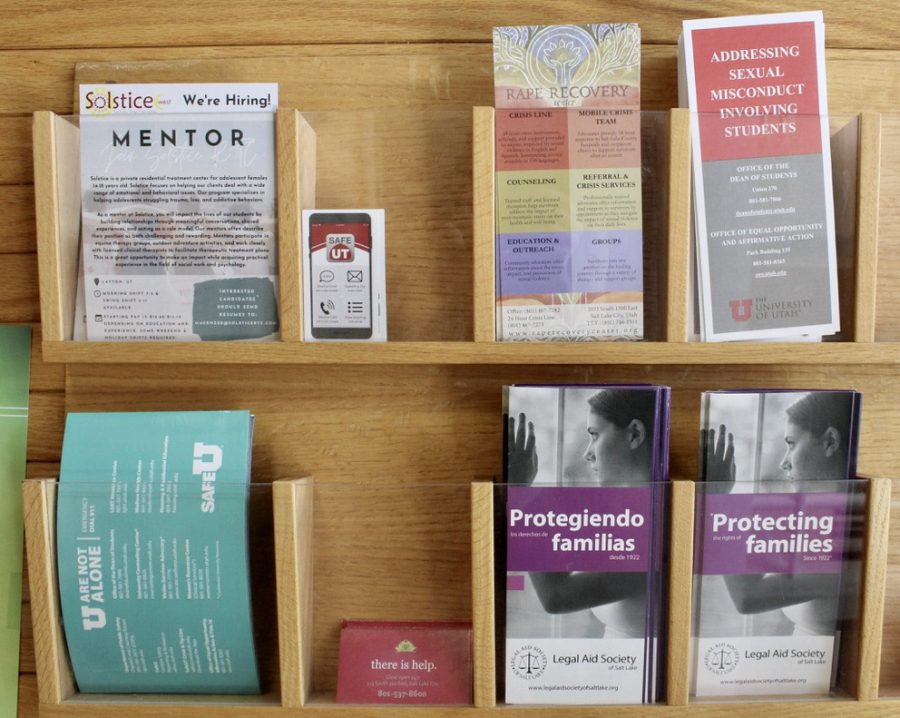Harm Reduction Training and the Return to Campus
Inside the University of Utah Student Services Building a wall displays pamphlets with resources for sexual assault and mental health in Salt Lake City, on Tuesday, June 9, 2021. (Photo by Brooklyn Critchley | The Daily Utah Chronicle)
August 27, 2021
As the end of the COVID-19 pandemic nears and campus is once again fully occupied, students and faculty are revisiting preventative safety measures against violent and drug-related crimes.
The University of Utah released its 2020 Annual Security and Fire Safety Report, made available each year to comply with the Jeanne Clery Disclosure of Campus Security Policy and Campus Crime Statistics Act.
According to the report, “burglaries decreased by 47% between 2018 and 2019. This is likely due to the fact that there was a serial burglar in 2018 who committed repeated offenses on campus and in Salt Lake. Additionally, domestic violence and fondling cases decreased, while dating violence, rape and stalking increased.”
The U Safety website says they worked to create resources available to support victims of sexual assault beginning in mid-2019. This includes creating a victim-advocate position. In 2019, there were 17 rapes on campus, 62 instances of stalking, five aggravated assaults and one hate crime that was described as a “simple assault.”
In October 2020, the community services department of the U hired two crisis support specialists — Evelyn Cervantes, who works with U Police for interpersonal violence, and Hillary White, a social worker experienced in trauma-informed crisis intervention for domestic violence survivors — to help support victims of crime on campus. “We do not only support victims with resources,” White said. “It’s about helping them during the process with questions about how to make a police report, questions about their families and their life after.”
According to the Center for Student Wellness, “stalking is a pattern of behavior toward another individual that would cause a reasonable person significant emotional distress.” “I am sure that I have a different perspective because I am a guy, but it is really unfortunate as most instances of stalking and violent crime are perpetuated on women, but also people of color,” said Brian McDonald, a third-year English student. “I am really worried for my friends. School should be a safe environment.”
The U offers a few educational presentations to aid in combating assault in hopes of preventing any more potential deaths on campus. The presentations are offered by U Police to anyone in the U community, including the U hospital. They offer an active shooter class, which is designed to prepare participants for mass casualty events, and a personal safety class, which helps improve situational awareness.
There is also a class called Rape Aggression Defense (R.A.D.), which is a program “of realistic self-defense tactics and techniques. The RAD System is a comprehensive course that begins with awareness, prevention, risk reduction, and risk avoidance while progressing to hands-on defense training basics.” U Police Associate Director Shawn Bryce and COP officer Jesse Buchanan did not respond to a request for comment, but information on requesting a presentation is available on the U Police website.
The McCluskey Center for Violence Prevention is also offering programs designed to educate people on relationship and sexual violence. The courses vary in time, but there is a 90-minute course specific to students and faculty to ensure they understand their roles in eradicating and preventing sexual violence on campus.
“I have personally experienced some scary things on campus, especially while leaving late at night,” said Meg Warnock, a fourth-year fine arts student. “Education should help students know how to take preventative measures, but hopefully we are also doing things to potentially intimidate predators on campus.”
The CSW provides the “Safe(r) Party Culture” course to help teach students how to interact with drugs and alcohol in a low-risk way so they can make safer decisions.
The inclusion of these types of programs is part of the U’s participation in The Drug-Free Schools and Communities Act, which certifies an “institution of higher education has adopted and implemented a program to prevent the unlawful possession, use or distribution of illicit drugs and alcohol for students and employees on school premises and as a part of its activities.”
The implementation of these programs and classes has stemmed from the Biennial Review for the Drug-Free Schools and Campuses, where they found that in 2018- 2019, “despite a relatively low percentage of students who drink alcohol, 67% of those that do reported binge drinking behaviors (5 or more drinks) the last time they ‘partied.’ Half of students who drink report doing something they regretted while drinking. Lastly, 1 in 8 students has reported using a prescription drug that was not prescribed to them. This is higher than the national average.”









